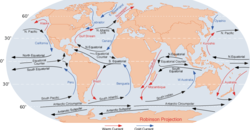
The Cape Horn Current is a cold water current that flows west-to-east around Cape Horn caused by the intensification of the West Wind Drift as it rounds the cape. [1]

The Cape Horn Current is a cold water current that flows west-to-east around Cape Horn caused by the intensification of the West Wind Drift as it rounds the cape. [1]